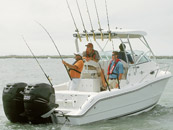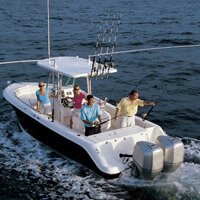Big-game fishing essentially didn’t exist until the advent of the motorboat. In 1898, C.F. Holder took a 183-pound bluefin tuna from a boat off Santa Catalina Island, California and inadvertently created a multimillion-dollar industry (and a darn good reason for owning a boat). The moniker “big game” generally applies to tuna, marlin, swordfish, and shark. A good fight with these bad boys requires a bit more technology than the bamboo cane Mr. Holder probably used, but that doesn’t mean you have to invest your life’s savings to have fun.
The basic equipment includes a rod, reel, line and the terminal tackle. This consists of some or all of the following: swivel, leader, hook, weight (sinker), lure (plug) or bait. You may also need a chum bucket and scoop (used for putting chopped bait into the water, usually when shark fishing). A stand-up belt allows you to rest the butt of the pole in a notch, giving you better leverage when fighting your catch.
Choosing a reel and a rod (usually called a blank) can be difficult, simply because there are so many choices. Many rod manufacturers provide guides to help you pick a suitable reel. The best advice is to talk with the pro in an angling specialty store (not a teenager in a sporting goods megamart).
There are three basic materials used in rods today — graphite, fiberglass and graphite/fiberglass composite. Graphite rods are extremely light and offer the highest sensitivity, but they are the most fragile. Fiberglass rods are tougher but not as sensitive. They are either solid or tubular (hollow cored). Composite rods employ both materials and offer a happy medium.
Big-game rods generally have stainless steel roller guides (the rings through which the line runs to the tip of the pole) that are designed for trolling and stand-up fishing. The rollers reduce friction and stress on the line during a fight. These rods also typically feature elongated foam grips that provide better traction and leverage for fighting big fish.
The test of a reel is how it performs over time. Cheap reels typically forego bearings for inexpensive brass or plastic shims, which wear and become sloppy over time. Better quality reels have three to five or more sets of ball bearings and will last over time. Good reels have three things in common: A large spool that should hold about 3,000 feet of line, a lever drag system that remains set and powerful gearing so you can pull the stretch out of the line if a fish goes deep.
Diameter, elasticity, stretch and knot strength all need to considered when choosing line. All nylon line stretches 10 and 35 percent under varying loads. Normal diameter lines resist abrasion better than super-thin line.
Your choice of hook type and size is definitely influenced by your line. All hooks come in a short, regular or long shank versions. The shank of the hook is the part between the eye of the hook and the bend.
There is an endless number of combinations possible with all of these pieces of equipment. The best way to choose is to ask a pro and to learn from your mistakes.
See Also:
- Secret Fishing Tips
- Bass Fishing Tips - 10 Bass Fishing Secrets from the Pros
- 27 Ways To Tell If You’re A Fishing Fanatic
- When To Fish
- Fighting A Fish
- Codes of Angling Ethics
- Fishing With Kids
- Where Do Fish Live?
- Discover Fishing
- Fishing Tips - Rod Storage
- Fly Fishing Boats
- What’cha Eating? Bait Matrix
- Ten Tips for Clean and Green Boating
- Fishing Accessories - Tips from the Boating Guy
- Boating is Affordable
- Saltwater Fishing Boats: Find a Fishing Boat at DiscoverBoating.com
- Saltwater Fishing Tips: Boating Information for Saltwater Fishing
- Sport Fishing Boats: Find A Fishing Boat
- Big Choices: The basics of big-game fishing equipment
- Saltwater Fishing Boats
- Selecting Your Saltwater Fishing Gear
- Selecting Fishing Tactics Overview


